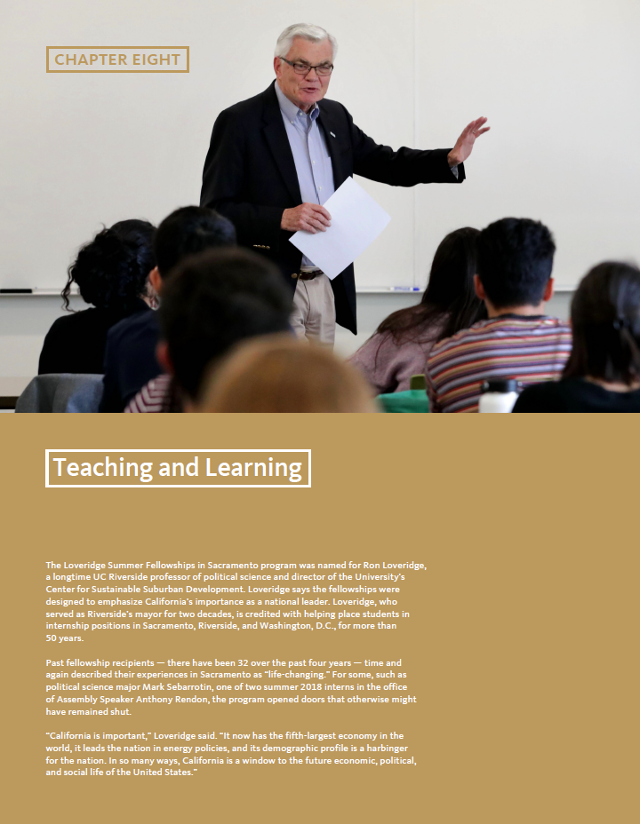
chapter spotlight
The Loveridge Summer Fellowships in Sacramento program was named for Ron Loveridge, a longtime UC Riverside professor of political science and director of the university’s Center for Sustainable Suburban Development. Loveridge says the fellowships were designed to emphasize California’s importance as a national leader. Loveridge, who served as Riverside’s mayor for two decades, is credited with helping place students in internship positions in Sacramento, Riverside, and Washington, D.C., for more than 50 years.
Past fellowship recipients — there have been 32 over the past four years — time and again described their experiences in Sacramento as “life-changing.” For some, such as political science major Mark Sebarrotin, one of two summer 2018 interns in the office of Assembly Speaker Anthony Rendon, the program opened doors that otherwise might have remained shut.
“California is important,” Loveridge said. “It now has the fifth-largest economy in the world, it leads the nation in energy policies, and its demographic profile is a harbinger for the nation. In so many ways, California is a window to the future economic, political, and social life of the United States.”
Overview
The University of California provides its students with a rich learning environment created by faculty engaged in both teaching and academic research. Student learning at UC involves classes, seminars, and lab sections enhanced by collaboration with faculty and researchers. Through these activities, faculty and students engage in a learning process that helps develop critical thinking, communication, and problem-solving skills, as well as discipline-specific knowledge.
Educating students and the public
UC’s faculty are principally responsible for maintaining UC’s academic excellence and promoting student success. Student retention, graduation rates, and measures of effectiveness are presented in Chapter 3. This chapter focuses on the learning experience of UC’s undergraduate and graduate students, reporting what skills they have learned, their engagement with faculty and their peers, and satisfaction with their UC experience. A majority of both undergraduate and graduate students report improvement in academic skills. This chapter also reports on the composition and workload of instructional staff across different academic disciplines and professional programs.
Expanding learning opportunities beyond students on campus demonstrates the connection between the teaching and the public service missions of the University. UC Extension offers adult professional and continuing education programs to Californians and people around the world. University Extension enrolls hundreds of thousands of Californians in its programs each year.
Promoting educational effectiveness
UC is committed to continuous improvement of instruction and employs a range of pedagogical and assessment strategies to enhance and support student learning. Campuses offer pedagogical development and training for faculty and teaching assistants to promote the use of evidence-based teaching practices and improve the quality of teaching and learning. UC’s teaching and learning centers and offices of instructional development train hundreds of instructors each year, improving the quality of education for students in all disciplines across all ten campuses.
UC promotes educational effectiveness by supporting assessment of student learning. Assessment strategies include the development of program-level student learning outcomes and integration of evidence of student learning into academic program reviews. Programs across UC are undertaking curriculum redesign and improvement as a result of assessment work. Much of this aligns with the expectations of regional accrediting agencies, in particular the WASC Senior College and University Commission (WSCUC). As part of WSCUC accreditation, UC campuses assess five main core competencies of student learning: writing, oral communication, quantitative reasoning, information literacy, and critical thinking. Each UC campus posts its WSCUC accreditation reports online.
Innovative instructional offerings
UC faculty develop and teach an ever-expanding catalog of online courses and programs, expanding learning opportunities for UC and non-UC undergraduates, graduates, and professional students. Through the UC cross-campus enrollment system, UC provides undergraduates access to high-demand courses offered at other UC campuses, increasing flexibility and opportunities for degree completion.
For non-UC students considering matriculation at a four-year university or resuming their studies, UC offers for-credit online courses that may transfer to other colleges and universities. UC Online provides courses that span a wide range of disciplines. UC Extension offers online continuing education courses, professional certificates and post-baccalaureate programs for those seeking to advance their education and to enhance their professional skills.
In addition to online courses, UC leverages instructional technologies to enhance instruction and promote success. UC continues to develop and refine hybrid courses using multimedia resources, videos, podcasts, e-books, and other technology-based tools. UC follows best instructional practices to embed innovative technologies into course design and focuses on creating online and face-to-face learning experiences that encourage collaboration and maximize faculty-student and peer-to-peer interactions. Increasingly, UC courses utilize a flipped model of instruction, where lectures and other traditional classroom content are provided online, and classroom time is dedicated to group discussions, problem-solving activities, and other experiential exercises.
Ongoing assessment and data-driven approaches to teaching and learning are integral parts of UC’s use of technology. Several UC campuses have adopted assessment systems that use online conceptual models and adaptive learning tools to determine students’ knowledge quickly and accurately. Based on responses to questions, the software determines concepts or topics where each student needs to focus. Assessment and LEarning in Knowledge Spaces (ALEKS) uses web-based adaptive tools to provide students with individualized feedback and learning pathways in entry-level math and chemistry courses. As part of the 2015 state budget framework agreement, three UC campuses engaged in a pilot study of the impact of adaptive learning technologies on student success and as a mechanism to strengthen instruction. The primary finding of the study was that when students use adaptive learning technology as intended, results are positive in relation to a student’s overall performance in the course to which it is applied.
UC is enhancing student learning opportunities and success by expanding summer course offerings (in-person and online) to reduce students’ time to degree and enrich their academic experience. Offering bridge experiences and orientation during summer also helps incoming students transition to campus life and prepare them for the rigorous courses at the undergraduate level.
For more informatioN
UC undergraduates experienced significant improvement between their freshman and senior years in multiple areas, including reading and comprehension, critical thinking, research competency, and understanding of their chosen field of study.
8.1.1 Self-reported skill levels from first year to senior year, Seniors who entered as freshmen, Universitywide, Spring 2018

Source: UCUES
The University of California Undergraduate Experience Survey (UCUES), which is conducted every two years, provides a valuable source of information on how UC undergraduates view their educational experience. These indicators also show students’ perception of how much they have developed core competencies of student learning. In UCUES, students are asked to reflect on their skill levels between their freshman and senior years. During this period, UC students self-reported significant improvements in all areas, including reading and comprehension, critical thinking, research competency, understanding international perspectives, and understanding of their chosen field of study.
Research participation is high among UC’s seniors across racial/ethnic and gender groups. Approximately three-quarters of all students completed research as part of their coursework and over one-third assisted faculty in research.
8.1.2 Students completing a research project or research paper as part of their coursework, Universitywide seniors, Spring 2018
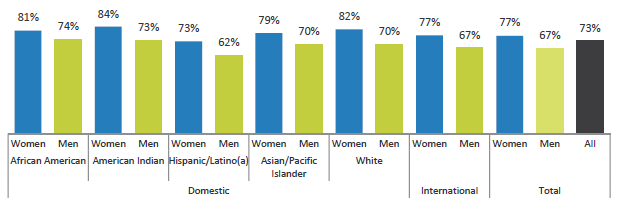
Source: UCUES
8.1.3 Students assisting faculty in conducting research, Universitywide seniors, Spring 2018

Source: UCUES
One of the benefits of attending an academic research university is the opportunity for undergraduates to conduct research, both through class research projects and by assisting faculty with their research. Overall, a high percentage of undergraduates reported that they participated in research. Women were more likely than men to indicate completing a research project or paper as part of their coursework. However, there was no difference in the proportion of women and men who reported having assisted faculty with research. Both of these findings held across racial/ethnic groups.
Engagement varies by discipline, with Arts and Humanities showing higher levels of engagement.
8.1.4 Student responses to questions about areas of engagement, Universitywide, Spring 2018
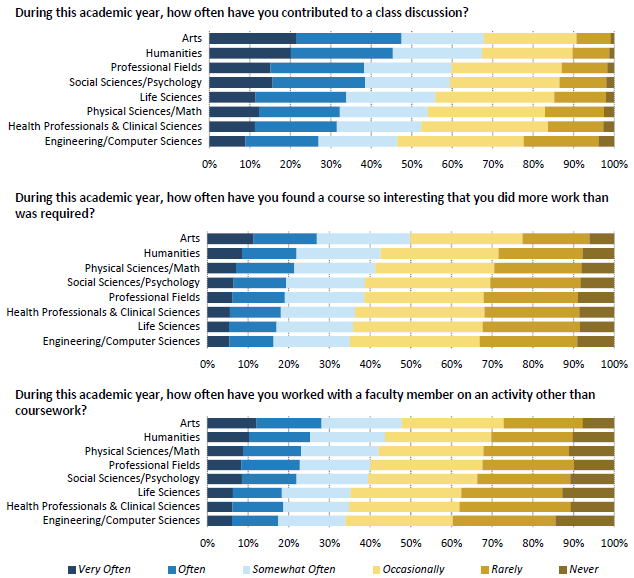
Source: UCUES
More than half of students reported that they contributed to class discussions at least somewhat often, and more than one-third at least somewhat often went beyond required coursework in a class they found interesting. Forty-one percent worked with a faculty member on an activity other than coursework, such as research or creative projects, at least once.
Satisfaction, particularly strong satisfaction, is declining Universitywide.
8.1.5 Student satisfaction with overall academic experience, Universitywide and UC campuses, Spring 2010 to 2018
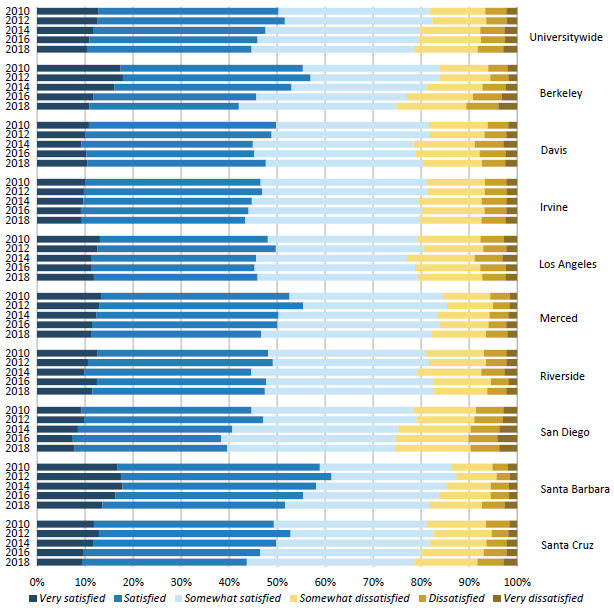
Source: UCUES. Note that this data includes all UCUES respondents; previous Accountability reports were limited to seniors.
For the UC system overall and for most campuses, the percent of students who were satisfied (somewhat through very satisfied) has remained as high as about 80 percent.
However, student satisfaction dropped slightly since 2012. Specifically, fewer students indicated that they were “satisfied” or “very satisfied” with their overall academic experience.
UC doctoral students credit their doctoral programs with having strengthened multiple skill sets, including research, writing, and presentation skills.
8.2.1 Self-reported skill levels after completion of doctoral program, Universitywide, Spring 2017

Source: UC 2017 Ph.D. Career Pathways Alumni Survey
In 2017, the Ph.D. Career Pathways Alumni Survey was sent to all University of California Ph.D. degree recipients — in all disciplines — who graduated during the 2001–02, 2008–09, and 2013–14 academic years. Similar to UCUES, it is a valuable source of information on how students viewed their educational experience. Among other questions, the survey asked for perceptions on how much students’ doctoral programs helped them acquire or develop core competencies of student learning.
Ph.D. degree recipients self-reported learning improvements in multiple areas, including research, writing, presentation skills, and the ability to critique and give feedback. Specifically, graduates pointed to their programs’ strength in developing the ability to critically analyze and evaluate findings and research. and to apply research methodologies, tools. and techniques appropriately. They also identified areas for improvement among doctoral programs, such as developing leadership, entrepreneurial, and financial and management skills.
The student-faculty ratio increased, especially for ladder-rank and equivalent faculty, during periods when faculty hiring did not keep pace with increasing student enrollment.
8.3.1 General campus student-faculty ratio, Universitywide, 2002–03 to 2017–18
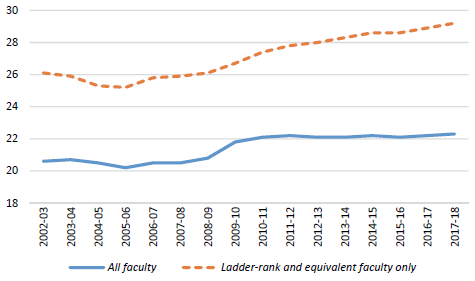
Source: UC Information Center Data Warehouse
One measure of academic quality is the student-faculty ratio. The student-faculty ratio reflects resources available for instruction and the average availability of faculty members to every student. Thus, lower ratios are preferable for students in terms of focused resources for instruction.
Because the student-faculty ratio varies considerably by degree, major, and instructional level (lower-division, upper-division, and graduate), student experiences will vary as well. Indicator 8.3.3 on student credit hours (SCH) provides additional insight into the student experience.
The student-faculty ratio has increased at various times in the University’s history and particularly in the last decade. During the most recent recession, campuses responded to uncertainty in state funding by delaying faculty hiring, or deciding not to fill vacant faculty positions on a permanent basis.
The expanding gap between the student-faculty ratio for all general campuses and the ratio for only ladder-rank and equivalent faculty illustrates the trend of hiring lecturers. Additional data can be found here: universityofcalifornia.edu/infocenter/student-faculty-ratio
8.3.2 Student credit hours, by instructional staff and class type, Universitywide, 2007–08 to 2017–18

Source: UC Faculty Instructional Activities dataset1
Student credit hours (SCH) represent the number of student enrollments in a course multiplied by the number of credits earned from that course. For example, a four-credit class with 50 students generates 200 SCH; a two-credit class of 15 students generates 30 SCH. This measure gives an indication of the relative teaching load across different types of instructors at different levels of instruction.
Over time, the full-time permanent faculty at UC have increased their teaching load and maintained contact with more undergraduate and graduate students. In 2017–18, full-time permanent faculty taught 200,000 more lower-division SCH than in 2016–17, whereas lecturers taught 18,000 fewer lower-division SCH in 2017–18 compared to 2016–17. Overall, a larger number of student credit hours offered by full-time permanent faculty means students have additional opportunities to be taught by leading scholars.
Lower-division courses such as writing, language, and other required courses are most often taught by lecturers; introductory courses to the major are most often taught by full-time permanent faculty. Upper-division courses, which are core to the student’s major, are more likely taught by full-time permanent faculty, as are graduate courses.
1 Data are for general campus courses only. These data are submitted annually by UC campuses and contain information on all general campus courses taught in that year.
As students enroll in upper-division and graduate classes, they have greater contact with full-time permanent faculty and smaller classes.
8.3.3 Student credit hours, by instructional staff and class type and class size, Universitywide, 2007-08 to 2017–18
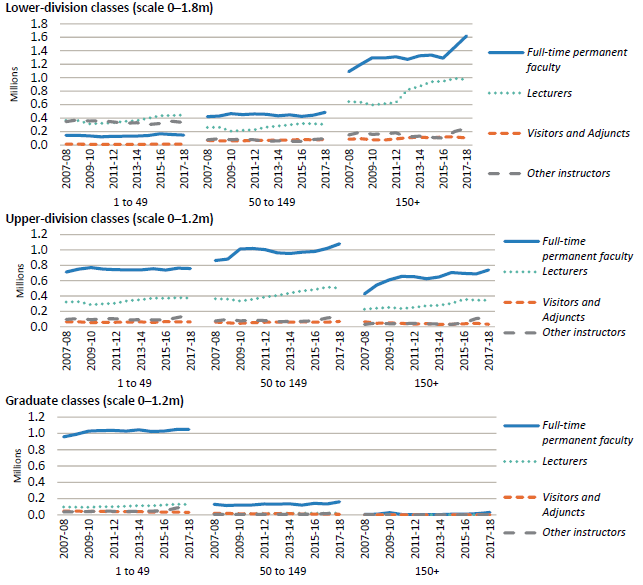
Source: UC Faculty Instructional Activities dataset
In the lower division, full-time permanent faculty generally teach large lecture classes; lecturers generally teach both large sections and smaller classes. In the upper-division, student contact with full-time permanent faculty is fairly evenly distributed across classes of all sizes.
Graduate academic students are almost uniformly taught by full-time permanent faculty in classes with fewer than 50 students. The large enrollment increases in 2016–17 and 2017–18 resulted in a substantial uptick in SCH being offered in large lower-division lecture classes.









